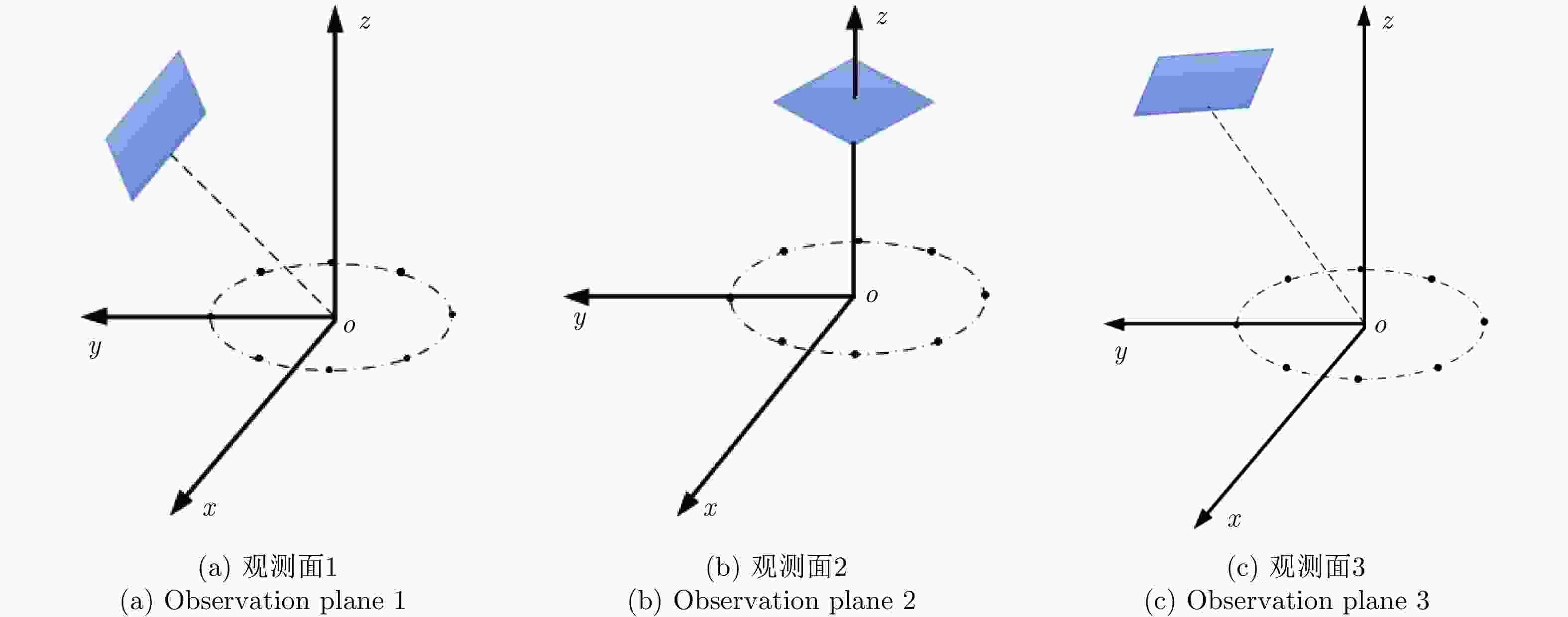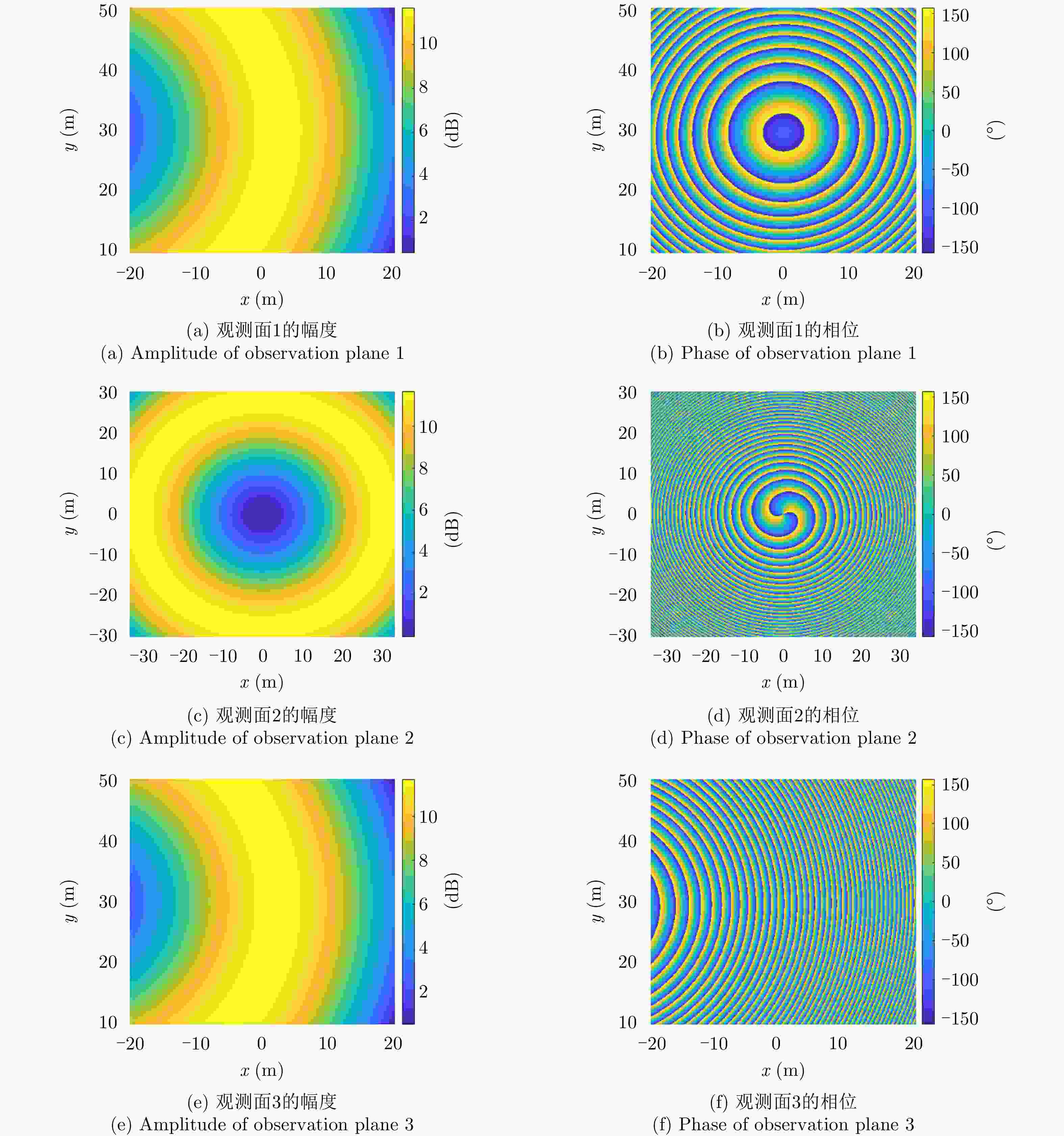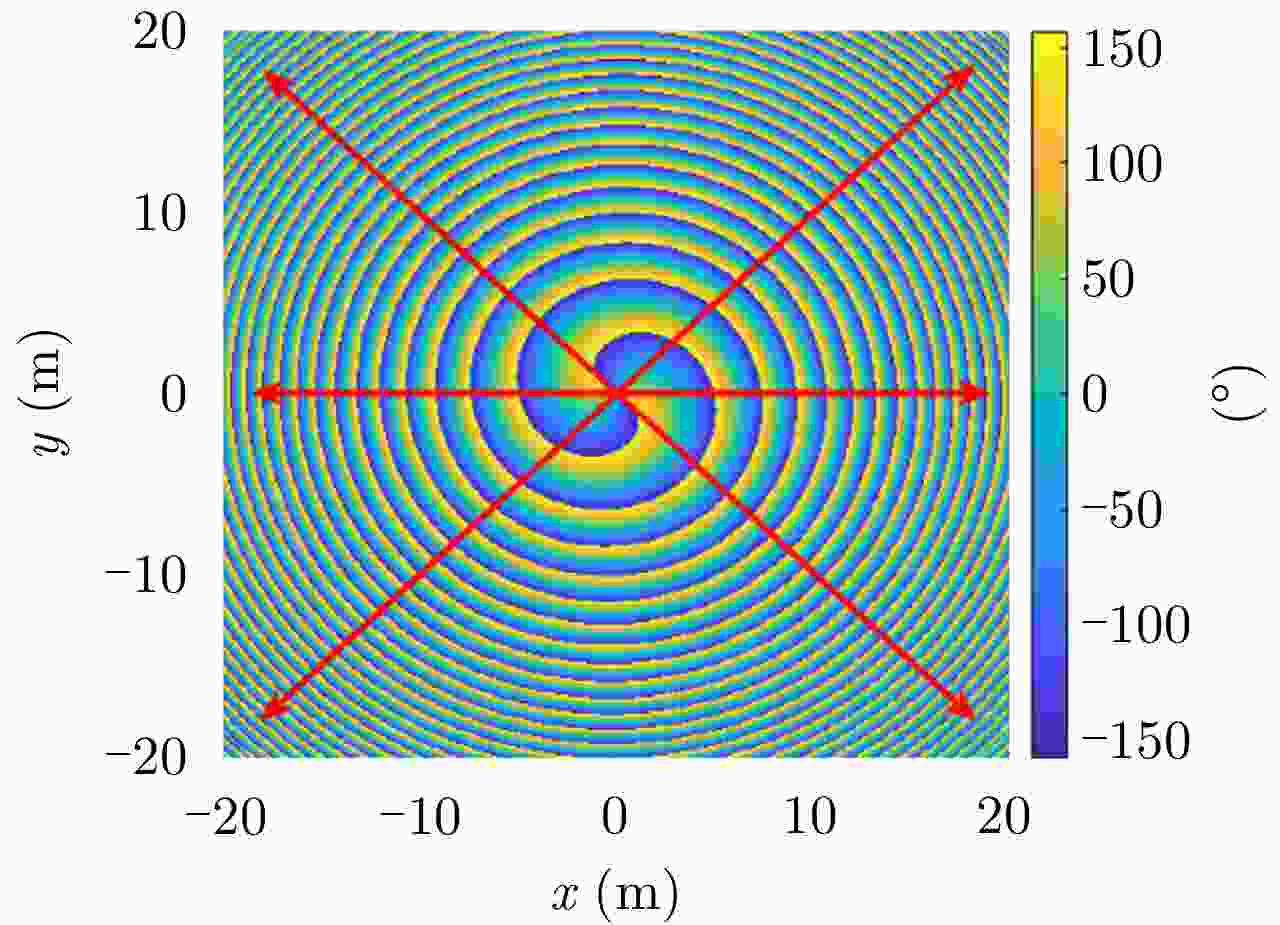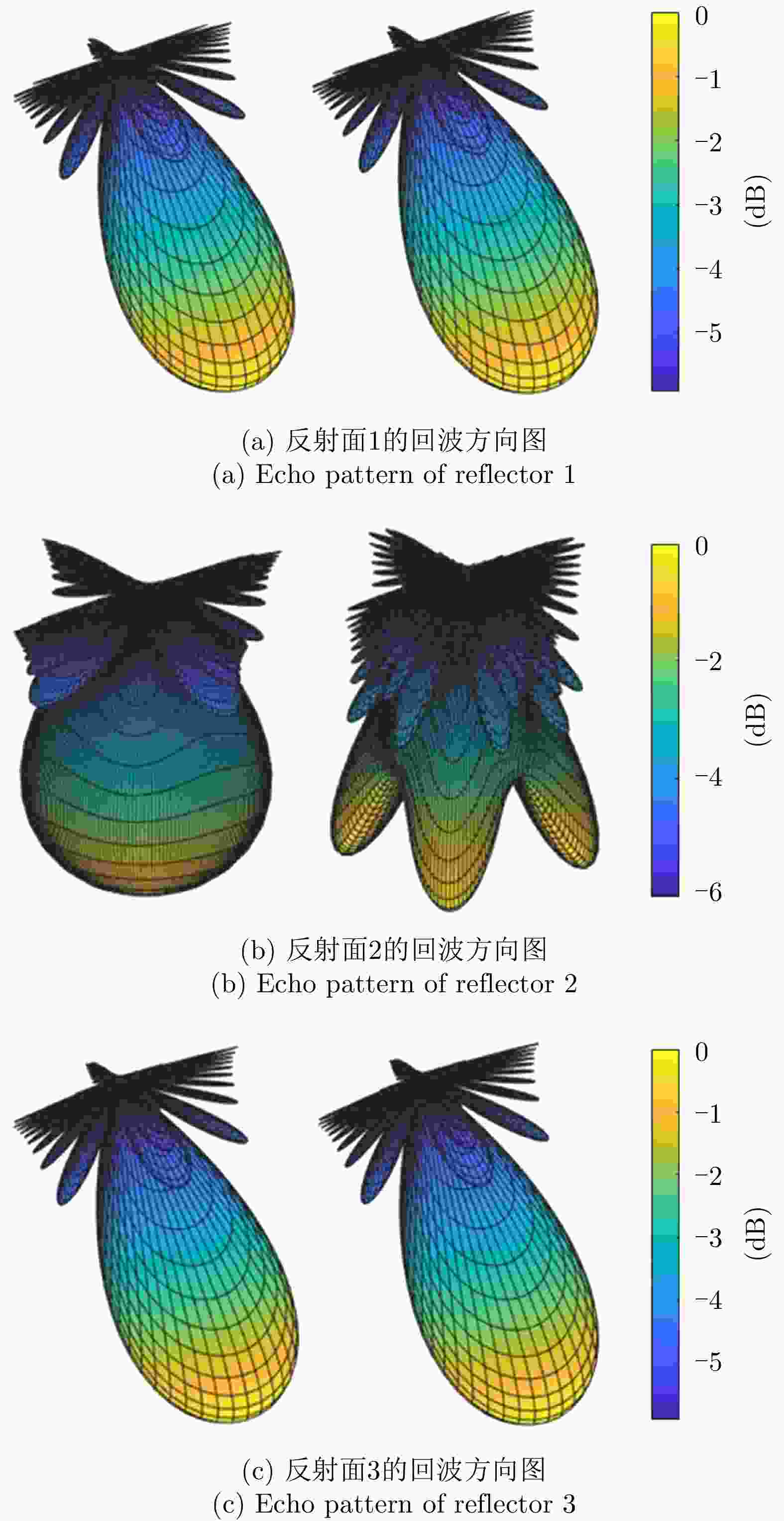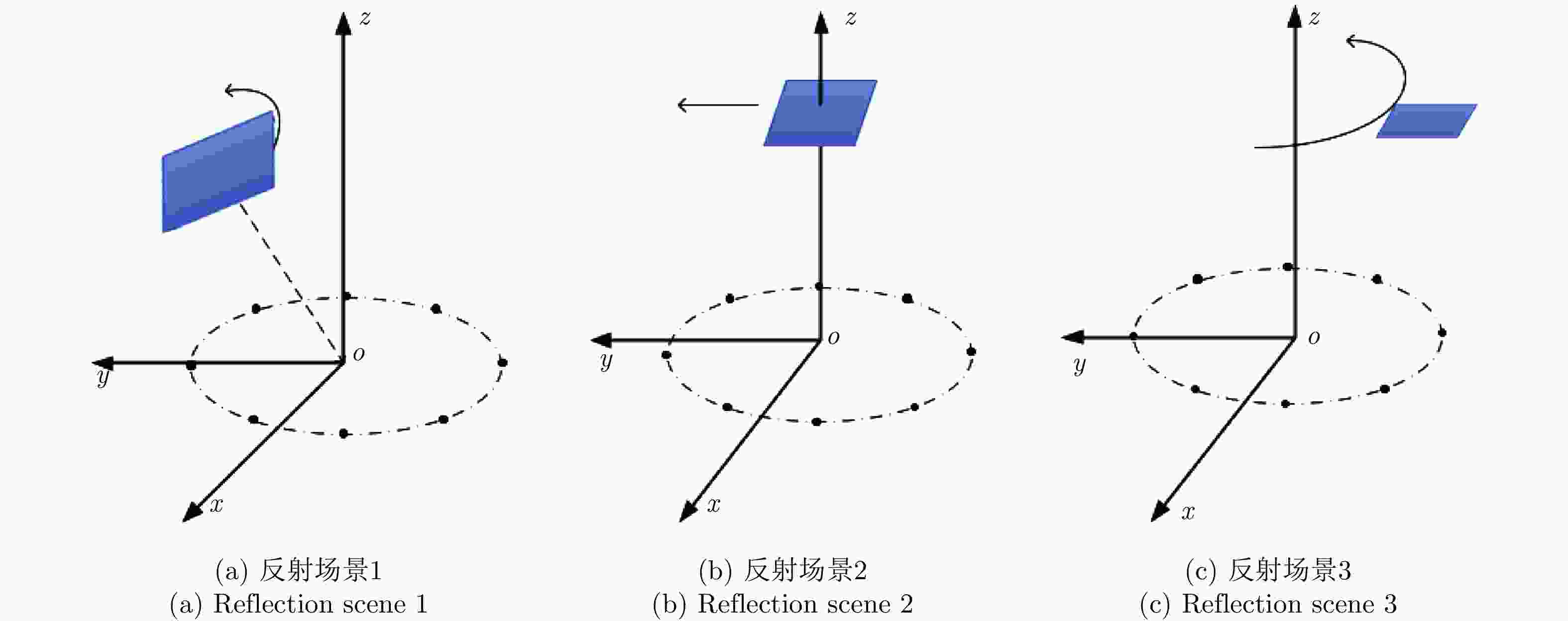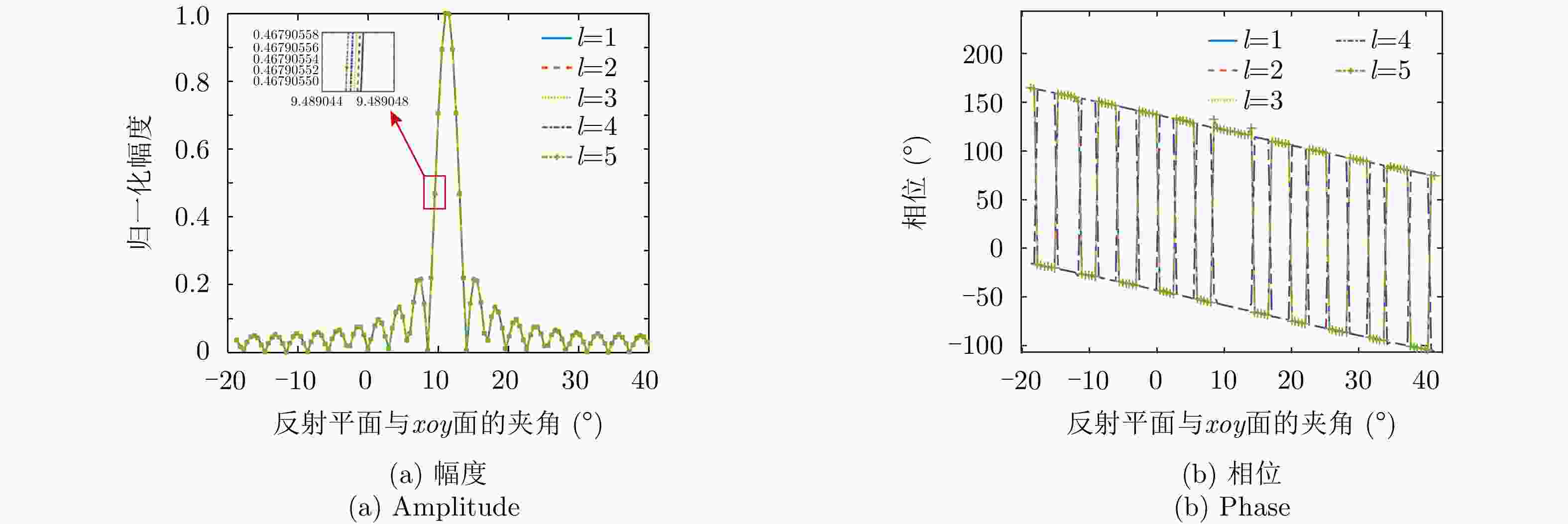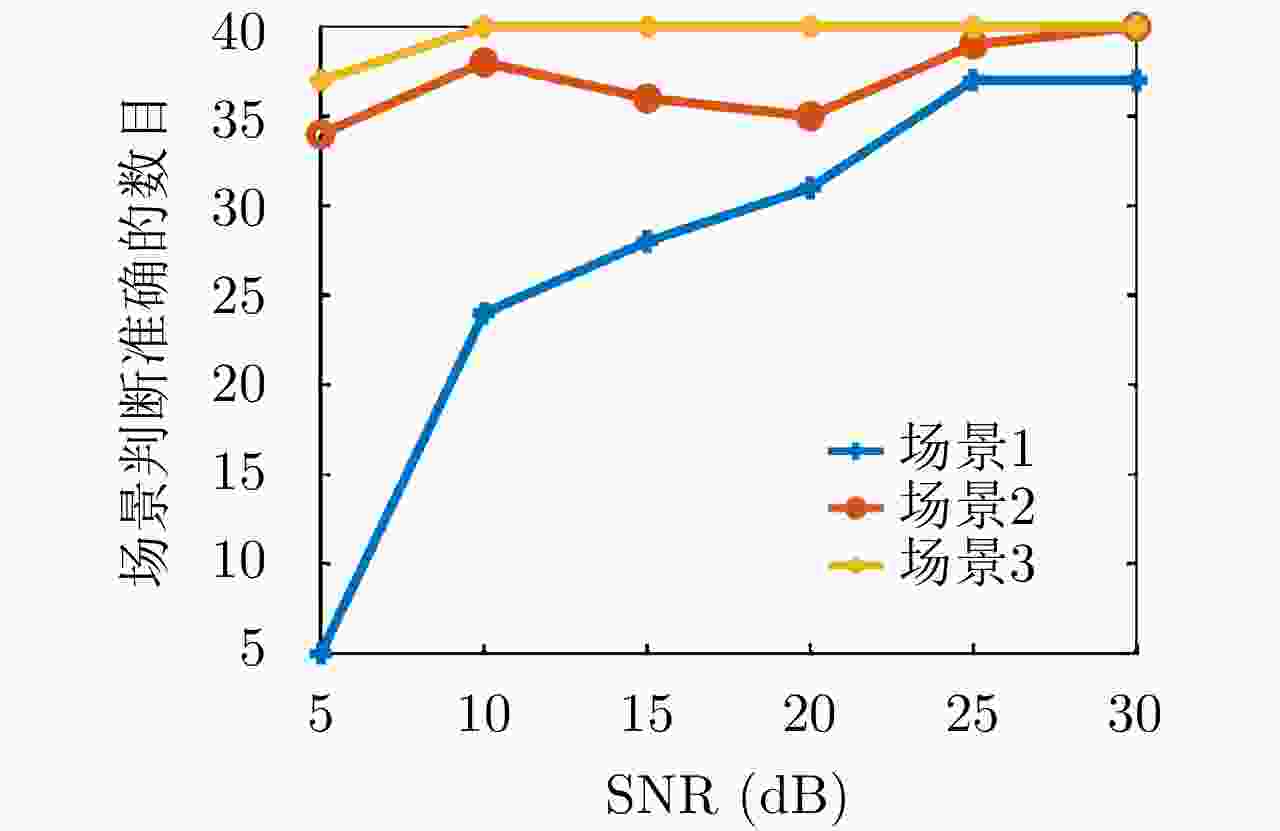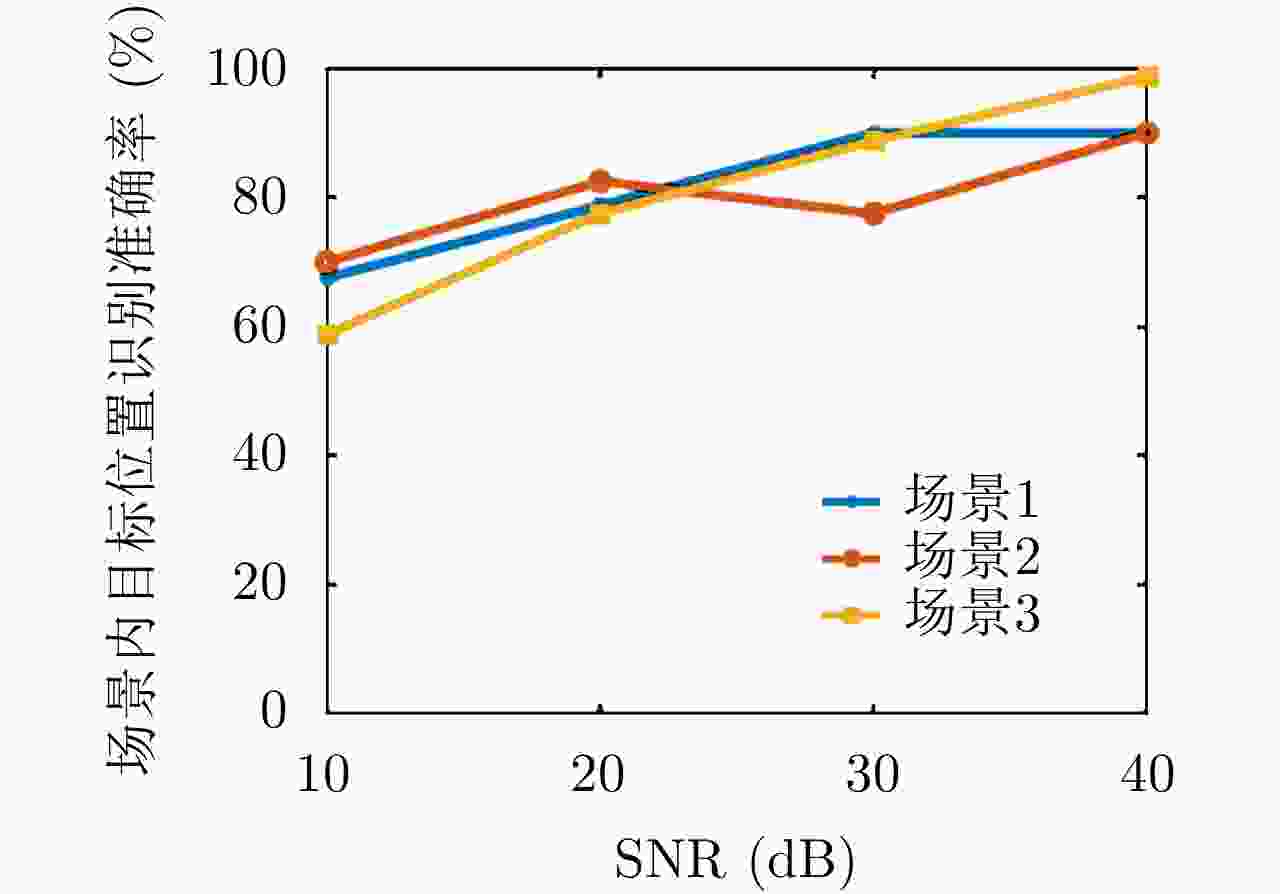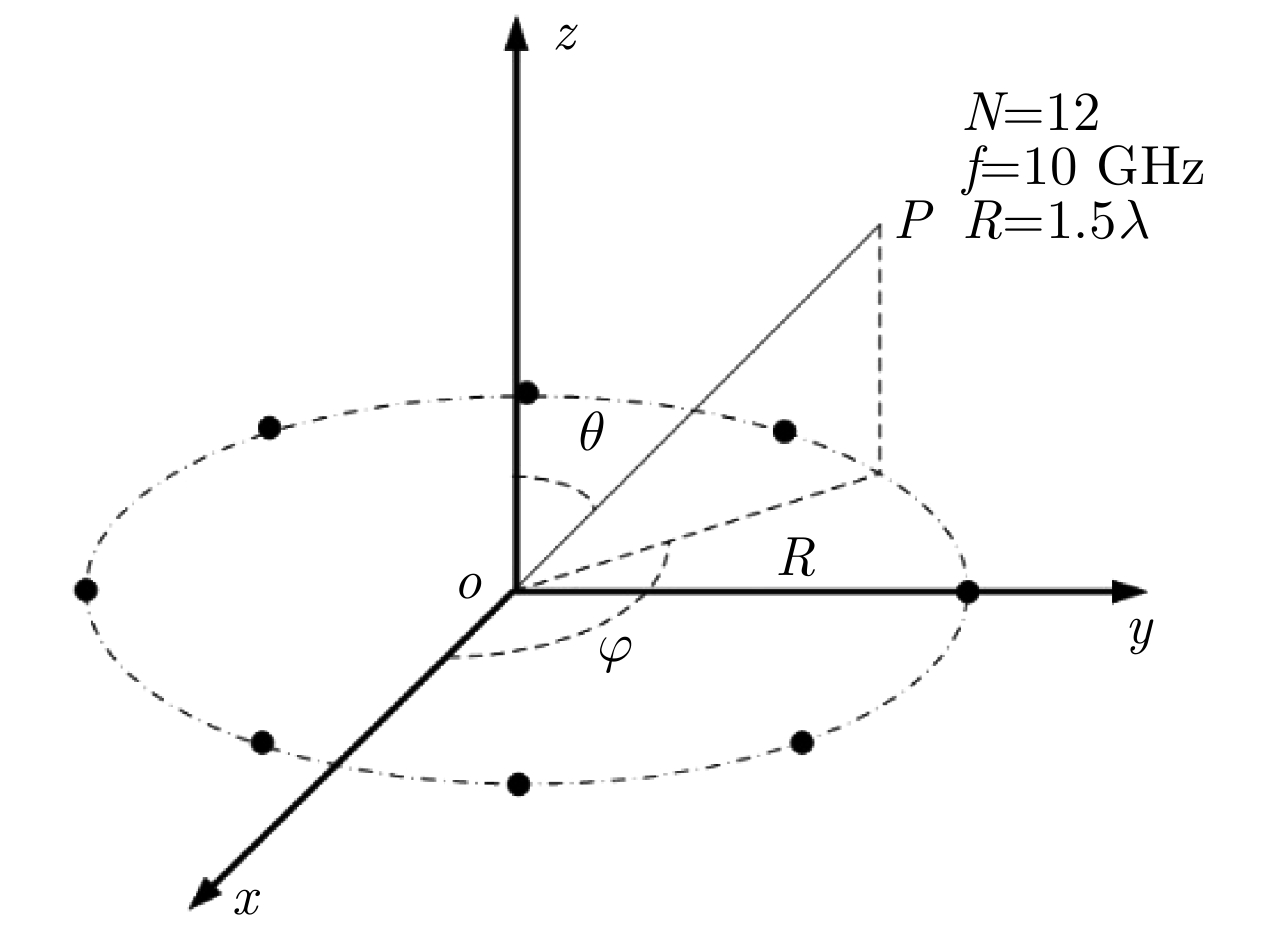-
摘要: 高效率目标探测需要借助探测信号的低相关性空间调制,调制数量大且具有时间独立性。携带轨道角动量(OAM)的涡旋波束具有无穷多种模态且不同模态之间相互正交,借助强色散材料可以实现频率域的多模态OAM波束产生。该文首先对OAM的传播特性进行推导,给出了符合探测需求的多模态OAM波束源特征;在此基础上,研究了不同模态的OAM波束在3种不同应用场景下目标反射回波信号特性,采用卷积神经网络对不同反射场景下的数据特征进行提取,实现了对未知场景的判断及场景内的目标识别,并进行了抗噪性能分析。实验结果表明:理想状态下,网络对目标场景判断的准确率可达
$97.5\% $ ;各反射场景中的两个相邻目标的间隔大于某一阈值时,网络对目标位置的识别准确率均高于$80\% $ 。但目标识别效果有环境依赖性,当${\rm{SNR}} < 20\;{\rm{dB}}$ 时,3种场景内的目标识别准确率均大幅降低。Abstract: Target detection based on space modulation requires a large number of test modes with space-time independence. The Orbital Angular Momentum (OAM) beams are orthogonal to each other and have infinite modes. Due to the strong dispersive materials, multi-mode OAM beams with the same scattering angle can be generated in the frequency domain. In this manuscript, the propagation characteristics of multi-mode OAM beams are analyzed, which can be utilized to improve detection efficiency. The echoes from the target illuminated by the multi-mode OAM beams are then investigated in three different application scenarios. A convolution neural network is employed to extract the relationship between the echo data and the target image based on prior knowledge. The target and the imaging scenarios can be distinguished with a high probability. Finally, the proposed method’s anti-noise performance is analyzed. The experimental results show that in the ideal state, the accuracy of target scene judgment can reach 97.5%. The accuracy of the target location recognition is higher than 80% when the interval between two adjacent targets in a scene is larger than a threshold. The accuracy of the target location recognition in three scenes is greatly reduced when SNR is less than 20 dB, depending on the scene. -
表 1 阵列的半径
Table 1. Radius of array
模态$ l $ 阵列半径R (m) 1 0.0450 2 0.0747 3 0.1026 4 0.1302 5 0.1569 6 0.1836 7 0.2097 8 0.2361 9 0.2619 表 2 OAM波束经反射面1的反射角
Table 2. Reflection angle of OAM beam passing through reflector 1
$ l $ $ \theta $ (°) $ \mathrm{\varphi } $ (°) 1 11.2523 89.9940 2 11.2523 89.9819 3 11.2523 89.9819 4 11.2523 89.9699 5 11.2523 89.9579 6 11.2523 89.9579 7 11.2523 89.9458 8 11.2523 89.9458 表 3 发射阵列及卷积神经网络的相关参数
Table 3. Parameters of transmit array and convolutional neural network
实验参数 参数值 频率 (GHz) 10 阵元数目 (个) 40 反射面尺寸 $10\lambda $ 迭代次数 100 反向传播学习率 1 -
[1] 郭桂蓉, 胡卫东, 杜小勇. 基于电磁涡旋的雷达目标成像[J]. 国防科技大学学报, 2013, 35(6): 71–76. doi: 10.3969/j.issn.1001-2486.2013.06.013GUO Guirong, HU Weidong, and DU Xiaoyong. Electromagnetic vortex based radar target imaging[J]. Journal of National University of Defense Technology, 2013, 35(6): 71–76. doi: 10.3969/j.issn.1001-2486.2013.06.013 [2] POYNTING J H. The wave motion of a revolving shaft, and a suggestion as to the angular momentum in a beam of circularly polarised light[J]. Proceedings of the Royal Society of London. Series A, Containing Papers of a Mathematical and Physical Character, 1909, 82(557): 560–567. doi: 10.1098/rspa.1909.0060 [3] ALLEN L, BEIJERSBERGEN M W, SPREEUW R J C, et al. Orbital angular momentum of light and the transformation of Laguerre-Gaussian laser modes[J]. Physical Review A, 1992, 45(11): 8185–8189. doi: 10.1103/PhysRevA.45.8185 [4] 付维杰. 基于超表面及波导结构的多阶OAM生成[D]. [硕士论文], 浙江大学, 2019: 11–13.FU Weijie. Multi-order OAM generation based on metasurfaces and waveguide structure[D]. [Master dissertation], Zhejiang University, 2019: 11–13. [5] 孙学宏, 李强, 庞丹旭, 等. 轨道角动量在无线通信中的研究新进展综述[J]. 电子学报, 2015, 43(11): 2305–2314. doi: 10.3969/j.issn.0372-2112.2015.11.025SUN Xuehong, LI Qiang, PANG Danxu, et al. New research progress of the orbital angular momentum technology in wireless communication: A survey[J]. Acta Electronica Sinica, 2015, 43(11): 2305–2314. doi: 10.3969/j.issn.0372-2112.2015.11.025 [6] 袁铁柱. 涡旋电磁波在雷达成像中的应用研究[D]. [博士论文], 国防科学技术大学, 2017: 94–101.YUAN Tiezhu. Research on radar imaging using electromagnetic vortex wave[D]. [Ph. D. dissertation], University of Defense Science and Technology, 2017: 94–101. [7] WANG Jianqiu, LIU Kang, CHENG Yongqiang, et al. Vortex SAR imaging method based on OAM beams design[J]. IEEE Sensors Journal, 2019, 19(24): 11873–11879. doi: 10.1109/JSEN.2019.2937976 [8] LIU Hongyan, LIU Kang, CHENG Yongqiang, et al. Microwave vortex imaging based on dual coupled OAM beams[J]. IEEE Sensors Journal, 2020, 20(2): 806–815. doi: 10.1109/JSEN.2019.2943698 [9] 杜永兴, 仝宗俊, 秦岭, 等. 基于改进BP算法的电磁涡旋成像方法[J]. 雷达科学与技术, 2020, 18(5): 539–545. doi: 10.3969/j.issn.1672-2337.2020.05.012DU Yongxing, TONG Zongjun, QIN Ling, et al. Electromagnetic vortex imaging method based on improved BP algorithm[J]. Radar Science and Technology, 2020, 18(5): 539–545. doi: 10.3969/j.issn.1672-2337.2020.05.012 [10] LIU Hongyan, WANG Yu, WANG Jianqiu, et al. Electromagnetic vortex enhanced imaging using fractional OAM beams[J]. IEEE Antennas and Wireless Propagation Letters, 2021, 20(6): 948–952. doi: 10.1109/LAWP.2021.3067914 [11] YU Meiping, HAN Yiping, CUI Zhiwei, et al. Electromagnetic scattering by multiple dielectric particles under the illumination of unpolarized high-order Bessel vortex beam[J]. Journal of Quantitative Spectroscopy and Radiative Transfer, 2017, 195: 107–113. doi: 10.1016/j.jqsrt.2017.01.005 [12] YAO Yu, LIANG Xianling, ZHU Maohua, et al. Analysis and experiments on reflection and refraction of orbital angular momentum waves[J]. IEEE Transactions on Antennas and Propagation, 2019, 67(4): 2085–2094. doi: 10.1109/TAP.2019.2896760 [13] LIU Kang, LIU Hongyan, SHA W E I, et al. Backward scattering of electrically large standard objects illuminated by OAM beams[J]. IEEE Antennas and Wireless Propagation Letters, 2020, 19(7): 1167–1171. doi: 10.1109/LAWP.2020.2993687 [14] GOODFELLOW I, BENGIO Y, COURVILLE A, 赵申剑, 黎彧君, 符天凡, 等译. 深度学习[M]. 北京: 人民邮电出版社, 2017: 11–22.GOODFLOW I, BENGIO Y, COURVILLE A, ZHAO Shenjian, LI Yujun, FU Tianfan, et al. translation. Deep Learning[M]. Beijing: People’s Posts and Telecommunications Press, 2017: 11–22. [15] LECUN Y, BOTTOU L, BENGIO Y, et al. Gradient-based learning applied to document recognition[J]. Proceedings of the IEEE, 1998, 86(11): 2278–2324. doi: 10.1109/5.726791 [16] KRIZHEVSKY A, SUTSKEVER I, and HINTON G E. ImageNet classification with deep convolutional neural networks[C]. The 25th International Conference on Neural Information Processing Systems, Red Hook, United States, 2012: 1097–1105. [17] KE Hengjin, CHEN Dan, LI Xiaoli, et al. Towards brain big data classification: Epileptic EEG identification with a lightweight VGGNet on global MIC[J]. IEEE Access, 2018, 6: 14722–14733. doi: 10.1109/ACCESS.2018.2810882 [18] KIM Y G and CHA E Y. Streamlined GoogLeNet algorithm based on CNN for Korean character recognition[J]. Journal of the Korea Institute of Information and Communication Engineering, 2016, 20(9): 1657–1665. doi: 10.6109/jkiice.2016.20.9.1657 [19] CHEN Hao, DOU Qi, YU Lequan, et al. VoxResNet: Deep voxelwise residual networks for brain segmentation from 3D MR images[J]. NeuroImage, 2018, 170: 446–455. doi: 10.1016/j.neuroimage.2017.04.041 [20] SHI Hongyu, WANG Luyi, PENG Gantao, et al. Generation of multiple modes microwave vortex beams using active metasurface[J]. IEEE Antennas and Wireless Propagation Letters, 2019, 18(1): 59–63. doi: 10.1109/LAWP.2018.2880732 [21] 陈亚南, 董晓龙. 基于轨道角动量的雷达关联成像技术研究[J]. 电子设计工程, 2018, 26(6): 109–113, 119. doi: 10.3969/j.issn.1674-6236.2018.06.024CHEN Ya’nan and DONG Xiaolong. Radar correlated imaging based on orbital angular momentum[J]. Electronic Design Engineering, 2018, 26(6): 109–113, 119. doi: 10.3969/j.issn.1674-6236.2018.06.024 [22] 谢处方, 饶克谨. 电磁场与电磁波[M]. 3版. 北京: 高等教育出版社, 1999: 333–334.XIE Chufang and RAO Kejin. Electromagnetic Field and Electromagnetic Wave[M]. 3rd ed. Beijing: Higher Education Press, 1999: 333–334. [23] 李玉鑑, 沈成恺, 杨红丽, 等. 初始化卷积神经网络的主成分洗牌方法[J]. 北京工业大学学报, 2017, 43(1): 22–27. doi: 10.11936/bjutxb2016060070LI Yujian, SHEN Chengkai, YANG Hongli, et al. PCA shuffling initialization of convolutional neural networks[J]. Journal of Beijing University of Technology, 2017, 43(1): 22–27. doi: 10.11936/bjutxb2016060070 -



 作者中心
作者中心 专家审稿
专家审稿 责编办公
责编办公 编辑办公
编辑办公



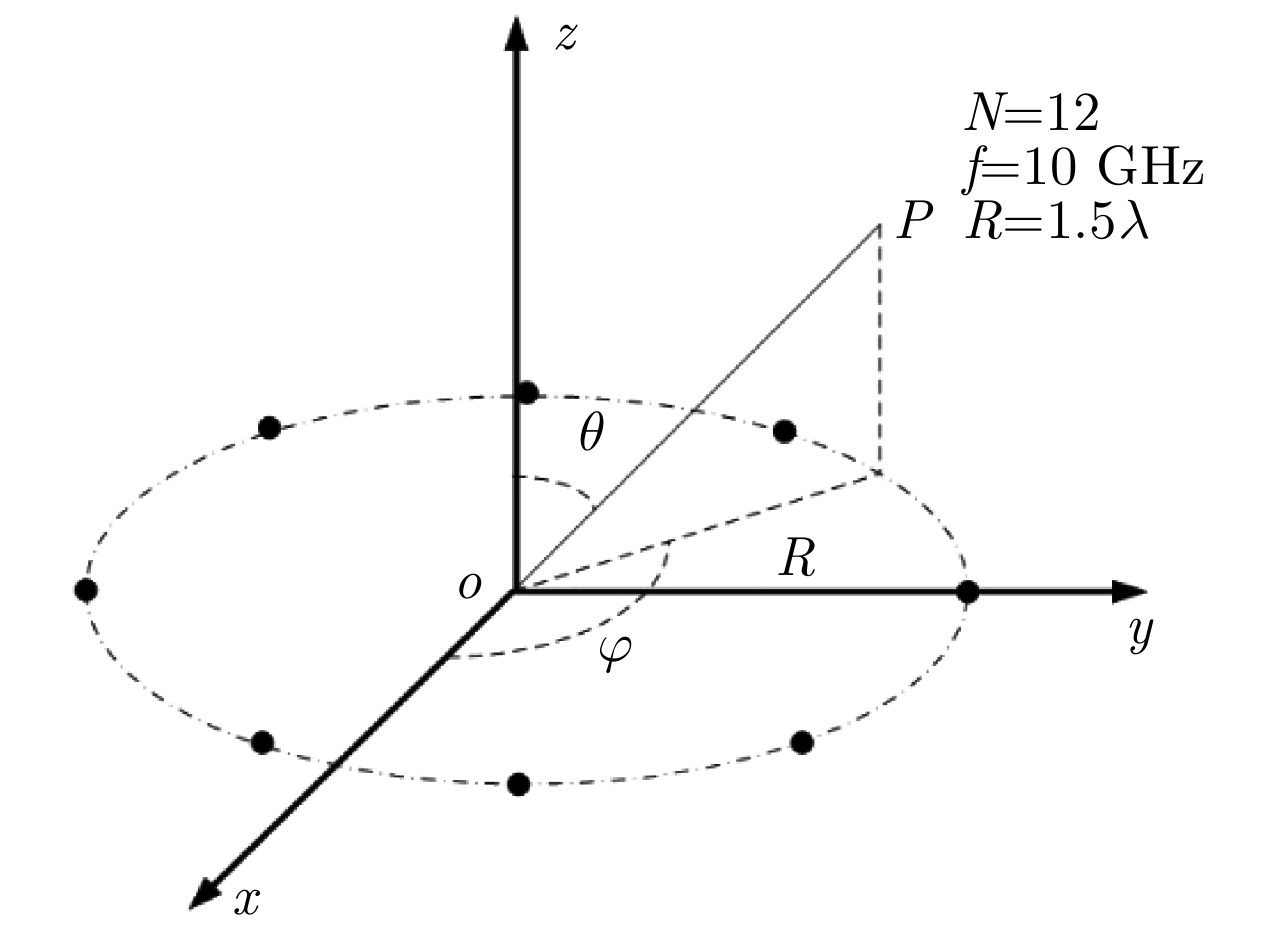
 下载:
下载:

